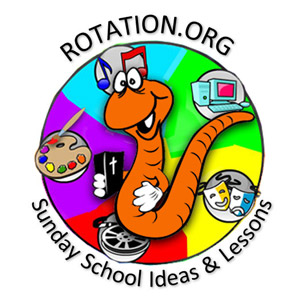People of the Early Church: Tabitha
Art Workshop
Scripture:
Acts 9:36-42
Summary of Lesson Activities:
Children will work together to create a simple blanket to donate to a blanket project (Note: this lesson expands on ideas previously posted at Rotation.org)
Lesson Objectives:
Children will...
- See and hear the story as Godly Play storytelling
- Learn about a blanket project
- Discuss ways they and their families can use their resources to help people in the community, the nation and the world
Workshop Preparation:
- Rehearse Godly Play story
- With both pieces of fleece safety pinned together, cut fringe all the way around the fabric, about 5 inches deep.
- Be familiar with www.binkypatrol.org (or look at the print-out of the home-page, attached) so that you can tell the children about how the blanket will be used
Supplies List:
- 2 1.5-yard pieces of polar fleece
- Fabric scissors
- Large safety pins
- Tabitha story set
- Security blanket
- Felt clothing cut-outs
- One large church cut-out
- 3 smaller church cut-outs
- Miniature food items
- 3x8” white felt “shroud"
- Small wooden "People of God" figures (https://www.godlyplayresources.com/)
- Brown Underlay (approx 18" x 24")
- The following disciple figures (paper or wood figures):
Peter
Tabitha
Widows (5)
Messengers (2)
Wooden Table (disciple figure size)
Lesson Plan
Opening:
Greet the children and introduce yourself.
Open with a prayer.
Dig:
Scripture Story
Use Godly Play story, below, based on Acts 9:36-42 from the International Children’s Bible
People of the Early Church: Tabitha
By Tanja Rouintree, based on Godly Play storytelling
Show the children the Bible
This story is from the Bible, from the New Testament book called The Acts of the Apostles.
Take a moment to allow the story to form inside you. As you speak, take the underlay and spread it out before you. Begin bringing out the People of God figures—about 6
After Jesus died and God raised him up, and after Jesus was taken up into heaven, the Holy Spirit came and drew people together to form the Church in Jerusalem.
Place the Jerusalem church to the right of center at lower edge. Continue speaking as you set out the rest of the People of God figures around the Jerusalem Church.
In the church there were many miracles. Many people believed in Jesus because of the miracles and because of what Jesus’ followers taught. The Church grew.
Some of the People went out from Jerusalem to other towns.
Move 3 sets of 2 figures to town locations.
Soon there were churches in other towns too.
Take the Peter figure out of the box. Start at the Jerusalem Church. Move Peter away from the Jerusalem church to each of the smaller churches. Leave him at the “Lydda Church.”
Put away the People of God figures
Put away the Jerusalem church and Set out the wooden table diagonally at the upper corner (leader’s edge).
Peter traveled to some of these churches to see how they were doing.
Bring out Tabitha.Put stack of clothing and basket of food beside Tabitha.
In the city of Joppa there was a believer named Tabitha.
… She was always doing good and helping people in need.
Bring out 5 widow figures. Put the clothes on them and give them food.
I wonder why Tabitha helped the people in need…
I wonder what it is like to be in need and to receive help…
While Peter was in a nearby town, Tabitha became sick and died. Her body was washed and put in a room upstairs.
Lay Tabitha down on the “bed” (wooden table). Put the “shroud” over her. Move the widows close to the “bed.”
Take the last two figures (messengers) out of the box. Move the messengers to the Lydda church, where Peter is.
The followers sent two men to Peter. They begged him, “Hurry, please come to us!”
Move Peter to the “Joppa church.”
Peter got ready and went with them. When he arrived, they took him to the upstairs room.
Point to the widows and their clothing.
All the widows (women whose husbands had died) stood around Peter, crying. They showed him the shirts and coats that Tabitha had made when she was still alive.
Peter sent everyone out of the room.
Move the widows and messengers to the lower edge (away from leader).
He kneeled and prayed.
Move Peter to stand by the wooden table.
Then he turned to the body and said, “Tabitha, stand up!”
Fold back the shroud half way.
She opened her eyes, and when she saw Peter, she sat up.
Stand Tabitha up.
He gave her his hand and helped her up.
Then he called the [believers] and the widows into the room.
Move the widows and messengers back to the “upper room.”
He showed them Tabitha; she was alive!
People everywhere in Joppa learned about this, and many believed in the Lord.
I wonder…
- Remember that you do not have to use all the “I wonder” statements—gauge your use of these discussion starters according to your students’ needs.
- Remember that silence is an appropriate response to an “I wonder” statement and to allow silent time for children to wonder with you before answering.
- Feel free to wonder out loud with the children, but resist the impulse to give the “right” answers. We are all in conversation with scripture. Sometimes the answer is the conversation.
See article on "I wonder" statements at the end of this lesson set.
I wonder how her friends felt when Tabitha got sick and died…
I wonder how Peter felt when he saw Tabitha’s friends crying …
I wonder what Peter was thinking about when he saw Tabitha dead…
I wonder what Peter prayed in the room with Tabitha …
I wonder what it was like to see that God made Tabitha alive again…
I wonder if an ordinary person can make a dead person live again…
I wonder how miracles show God’s power…
I wonder how miracles help us believe in God…
Activity (application):
- Show children the security blanket. Ask if any of them have a special soft “blankie” or stuffed animal. Discuss how these items help us to feel safe and comfortable.
- Tell the children that we can make something to help people like Tabitha did. Talk about how sometimes children end up without homes. (No need to bring up removing children from their homes due to abuse. Most children will probably relate better to accidents or storms destroying their homes.)
- Tell the children about the blanket project and how the blanket they will make will be used. Some people collect hand made blankets to give to children who have lost everything. The blankets help them to feel safe and comfortable.
- Spread the pieces of fleece on the floor together (these pieces should already be pinned together).
- Show children how to tie the fringes together (holding the two layers together, tie one simple knot on each fringe), starting at a corner.
- Help younger children who may not know how to tie yet.
- While the kids are working, ask questions to stimulate discussion on things we can all do to help people (not just poor, but also victims of disasters, crime or abuse)
- If younger children get bored, you can have the shepherd do the memory verse activity with them or some other activities provided.
- Send the blanket to: Binkie Patrol,PO Box 1468, Laguna Beach, CA 92652-1468
Reflection:
Imagine the child who is going to get the blanket you helped to make. How do they feel when they receive it?
Closing Prayer
References:
Various Rotation.org lessons, and
Stewart, Sonja M and Berryman, Jerome W., Young Children and Worship. Westminster John Knox Press, Louisville. 1989.
https://www.godlyplayresources.com/
A lesson from First Presbyterian
Nevada, MO
A representative of Rotation.org reformatted this post to improve readability.


